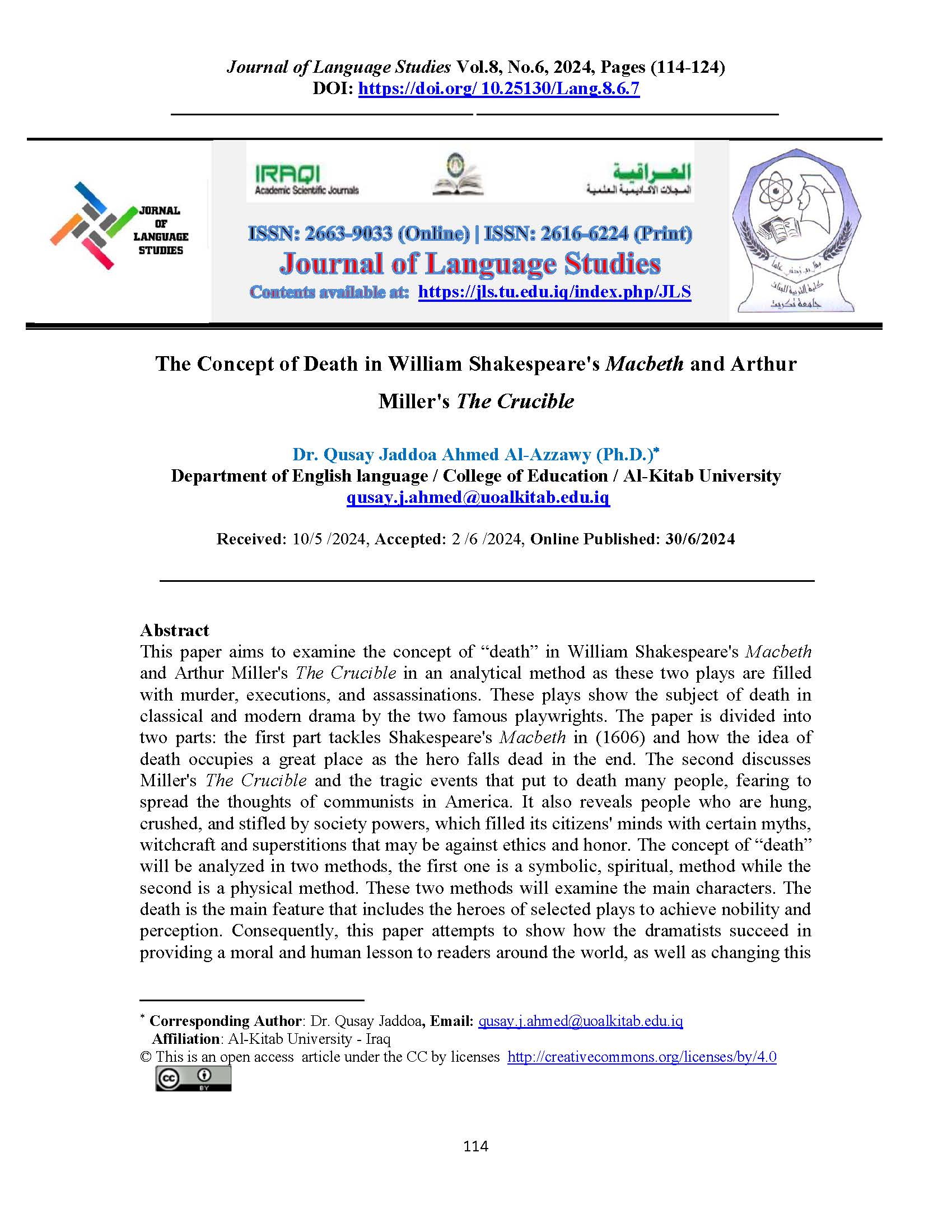The Concept of Death in William Shakespeare's Macbeth and Arthur Miller's The Crucible
DOI:
https://doi.org/10.25130/Lang.8.6.7Keywords:
Ambition, Church, Death, Power, Prophecy, WitchcraftAbstract
This paper aims to examine the concept of “death” in William Shakespeare's Macbeth and Arthur Miller's The Crucible in an analytical method as these two plays are filled with murder, executions, and assassinations. These plays show the subject of death in classical and modern drama by the two famous playwrights. The paper is divided into two parts: the first part tackles Shakespeare's Macbeth in (1606) and how the idea of death occupies a great place as the hero falls dead in the end. The second discusses Miller's The Crucible and the tragic events that put to death many people, fearing to spread the thoughts of communists in America. It also reveals people who are hung, crushed, and stifled by society powers, which filled its citizens' minds with certain myths, witchcraft and superstitions that may be against ethics and honor. The concept of “death” will be analyzed in two methods, the first one is a symbolic, spiritual, method while the second is a physical method. These two methods will examine the main characters. The death is the main feature that includes the heroes of selected plays to achieve nobility and perception. Consequently, this paper attempts to show how the dramatists succeed in providing a moral and human lesson to readers around the world, as well as changing this terrible truth of murder into something highly meaningful that it is a step towards the eternal life.
References
Baker, Christopher. “Saint Peter and Macbeth’s Porter.” The Ben Jonson Journal 18.2 (2011): 233-253. Edinburgh: Edinburgh University Press. Web. 13 January 2015.
Brooke, Stopford Augustus. On ten plays of Shakespeare. New York, University of California, Constable Limited, 1971.
Brooks, Rebecca Beatrice. "Abigail Williams: The Mysterious Afflicted Girl." 6 October 2015. History of Massachusetts. Retrieved from historyofmassachusetts.org/abigail-williams-salem/, at 10 May 2023.
Jack, Jane. “MacBeth, King James, and the Bible.” ELH 22.3 (Sep. 1955): 173-193. The Johns Hopkins University Press. Web. 9 January 2015.
Kinney F, Arthur. Renaissance Historicisms: Essays in Honor of Arthur F. Kinney. edited by James M. Dutcher and Anne Lake Prescott. Newark: University of Delaware Press. 2008.
Miller Arthur, Collected Plays (London: Penguin Books, 1958), 249.
Miller, Arthur. The Crucible. Second Indian Reprint. Surjeet Publications. University of Delhi, India, 2008.
Moore, Mavor. “Shakespeare and witchcraft.” In Stratford Papers On Shakespeare. Ed. B.W. Jackson. Toronto: W.J. Gage, 1962. Print.
Muir, Kenneth, ed. Macbeth. By William Shakespeare. New York: Bloomsbury Arden Shakespeare, 2013. Print.
Pakistan Journal of American Studies, Vol. 25, Nos. 1 & 2. Spring & Fall 2007.
Pishkar Kiyan and Nasery Nooshin. Comparative study of theme of love in Sonnets of Shakespeare and Hafiz. Volume No.2 Issue No.4December 2013. www.iresearcher.org ISSN 227-7471.
Robbins, Rossell Hope. The Encyclopedia of Witchcraft and Demonology. New York: Crown Publishers, 1959. Print
Shakespeare, William. Macbeth. Ed. George Hunter. Reprinted edition, Penguin books. England, 2005.
Starkey Marion Lena, The Devil in Massachusetts. (New York: Anchor Books/Random House, 1969/1989).
Alwan, Dheyaa Ramadhan. "Exploring the Inevitability of Death in Elizabeth Barrett Browning's 'The Cry of the Children'." Journal of Language Studies, vol. VI, no. 4, 2023, pp. 119-128.

Downloads
Published
Versions
- 2024-06-30 (2)
- 2024-06-30 (1)
